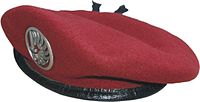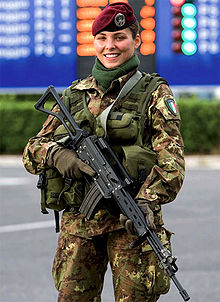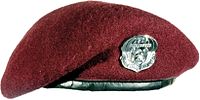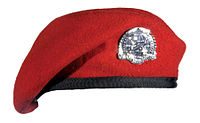- Maroon beret
-
The maroon beret is a military beret and has been an international symbol of elite airborne forces since it was chosen for British airborne forces in World War II. This distinctive head dress was officially introduced in 1942, at the direction of General Frederick Browning, commander of the British 1st Airborne Division.[1] The colour of the beret was reportedly chosen by his wife, the novelist Daphne du Maurier.[1] It was first[citation needed] worn by the men of the Parachute Regiment in action in North Africa during November 1942. Although maroon, the beret of the British Parachute Regiment is often known as the "red beret."
Australian Army
Maroon berets are worn by paratroopers in the 3rd Battalion, Royal Australian Regiment and A Field Battery or any soldiers within the Airborne Battle Group (Transport, Catering, Medical etc.). Previously also by the Australian Special Air Service Regiment, however this was replaced by the tan beret (sometimes referred to as the sandy beret).
Bangladesh Army
All members of the Bangladesh Army special forces para commando battalions wear Maroon Berets with para commando cap badge. Besides all members of the Army Medical Corps, Army Dental Corps and Armed Forces Nursing Services of Bangladesh Army wear Maroon Berets with respective cap badges.
Belgian Army
The Paracommando Brigade (Belgium) wear the maroon beret with various types of cap badges.
Brazilian Army
In the Brazilian Army, the use of maroon berets and brown boots is restricted to the members of the paratroopers brigade—Pqdt (paraquedistas)—one of the elite regiments of the Brazilian Armed Forces.
British Army
British Army Regiments wear distinctive headdress and cap badges which often reflect regimental history.
Members of the Parachute Regiment and other arms in 16th Air Assault Brigade are permitted to wear the maroon beret irrespective of qualification as military parachutists. The beret is often called the "red beret" and the Parachute Regiment is known as the "red berets" or (within the Army) the "maroon machine".[2][3]
Canadian Forces
Jump-qualified personnel in parachute units of the Canadian Forces are allowed to wear the maroon, provided they are in a designated parachute position. These are as follows:
- B Company, 3rd Battalion Princess Patricia's Canadian Light Infantry
- M Company, 3rd Battalion The Royal Canadian Regiment
- A Company, 3rd Battalion Royal 22e Régiment
- Parachute Company, The Queen's Own Rifles of Canada
- Instructors, packer/riggers and jump slotted members of the Canadian Forces Land Advanced Warfare Centre (CFLAWC) at CFB Trenton
- The Canadian Airborne Regiment(disbanded September 1995)
- E Troop, E Battery, 2 RCHA (Stood up March 2011)
Chilean Army
Since the creation of the Armored Cavalry in the Army, all personnel who serve in the Armored Cavalry unit wear maroon berets, using the same badges regardless of each member's speciality. Specialists in Armored Cavalry are trained in the Escuela de Caballería Blindada del Ejército (Armored Cavalry School of Army), and currently it is only branch of service whose members all wear berets; the other berets used in the Chilean Army distinguished only specialists (mountain troops, paratroopers, or special forces) and, in the last years, the combined branch of service regiment, called Regimientos Reforzados.
Danish Army Special Forces
Danish Army Special Forces, Jægerkorpset wears the Maroon Beret with a brass emblem depicting a hunters bugle on a black felt liner. The beret is issued after completion of 16 weeks of SF training. However, not before 1 year of additional satisfactory service in JGK is the wearer issued the shoulder patch "JÆGER" and may call himself by this name.
French Army
Since the First Indochina War, the French paratroopers wear a dark red beret. French Foreign Legion paratroopers wear a green beret though.
Finnish Army
The Finnish parachute jaeger corps (Finnish: Laskuvarjojääkärikomppania) trains personnel in the Utti Jaeger Regiment, Utti, Finland. Jump-qualified personnel are allowed to wear the maroon beret.
German Army
A maroon beret is worn by the German Kommando Spezialkräfte (KSK, Special Forces) and by all members of the Division Spezielle Operationen (DSO, containing airborne troops) and the Division Luftbewegliche Operationen (DLO).
Guatemalan Army
Maroon berets are worn by Kaibiles, Guatemala's special forces.
India
Army
The Indian Army parachute-trained units, including the minor/support units of the parachute brigade and the special forces units wear the maroon beret. The Special Frontier Force of the Home Ministry are also parachute trained and wear the maroon beret.
Para-Military Forces
The specially trained part of the Central Industrial Security Force for the protection of airports and other vital installations take the cue from the Army's Special Forces and have adopted the Maroon Beret as their headgear, though they are not parachute trained, thus diluting the airborne ethos.
Indonesian Army
Maroon beret is the official headgear of Army Aviation Center. This beret is worn by all its personnels. Established on March 23, 2007, the beret replaced all the berets previously used by the personnels.
Israeli Army
In the Israel Defense Forces, maroon beret is worn by the Tzanhanim Airborne Brigade and elite special forces units (Sayeret Matkal, Oketz, Maglan, Duvdevan and others).
Italian Army
In the Italian Armed Forces, maroon beret is only worn by paratroopers of the Folgore Brigade and Carabinieri paratroopers unit, the Carabinieri Regiment "Tuscania"
Malaysian Army and Police
Army
The Malaysian Army's elite 10 Paratrooper Brigade has worn the maroon beret since its establishment in 1994.
Police
The Malaysian Police Pasukan Gerakan Khas A-Detachment or Special Actions Unit has worn the maroon beret since in 1975.
Mexican Army
The maroon berets are worn by Mexico's Parachute Rifle Brigade called the Brigada de Fusileros Paracaidistas created in 1969 as a rapid response team.
Netherlands Army
The Dutch Army's Air Mobile Force, 11 Luchtmobiele Brigade, which translates to Air Mobile Brigade, wear "The Maroon Berets" (aka the Red Beret) as a sign of their status upon completion of their training.
Norwegian Army
The Norwegian army special forces has worn the maroon beret since its establishment in 1981.
Pakistan Army
The Special Service Group (SSG) wears a maroon beret with a silver SSG badge on a sky blue flash. Line infantry regiments which were parachute trained wore their own regiments' berets till airborne role was taken away from infantry and assigned to SSG which became the army's only airborne outfit from 1964 onwards. In addition to SSG, Army Aviaiton and Air Defence wear maroon berets
Navy's Special Service Group, SSG(N) wear maroon berets
Pakistan Airforce
PAF's elite Special Service Wing (SSW) wears maroons berets
Polish Army
Maroon beret is worn by paratroops, for its colour called in Polish Czerwone Berety, and also: air cavalry and special forces. The beret is always decorated with embroidered White Eagle (Polish coat of arms) and rank insignia. It is used as well with ceremonial uniform and field uniform.
Russian Armed Forces
The maroon beret is worn by members of elite MVD Spetsnaz units, although it is referred to as 'Krapoviy' meaning crimson. In a contrast to the Western style, Russian troops wear the badge over the right eye on the beret. In the Soviet era, paratroopers wore a maroon beret until the early 1960s when General Vasily Filipovich Margelov decided that a maroon beret for paratroopers was a Western idea and introduced a cornflower blue beret. This may have been influenced by the cornflower blue of the Soviet Air Force and the cornflower blue helmets worn by Soviet paratroopers during the Great Patriotic War.
Military of Serbia
Special Brigade
Singapore Armed Forces Commandos
The Maroon Beret or Red Beret is worn by the elite commandos of the Singapore Armed Forces depicting their status as an elite airborne and special forces unit.
South African Special Forces and Paratroops
The maroon beret is worn by both the Special Forces Brigade, the former 44 Parachute Brigade 1978 to 1999 and currently 44 Parachute Regiment 2000 to present
Spanish Army
The 1st King's Immemorial Infantry Regiment of AHQ, the oldest military unit in the world, wears the maroon beret.
Sri Lanka Army
The Commando Regiment of the Sri Lanka Army wears the maroon beret, and is the only Sri Lankan military unit to use it.
Swedish Army
A maroon beret is worn by Fallskärmsjägarna (or Fallskärmsjägarkåren: Parachute Ranger Corps), a jump qualified Swedish military special operations unit. The unit is an airborne commando unit focused on intelligence gathering and squad to platoon level combat deep behind enemy lines.
Royal Thai Army
The Royal Thai Army Special Operations Force and paratroopers in the 31st Infantry Regiment (Royal Guard) wear the maroon beret.
Turkish Army
The Turkish Army's Special Operations Force, Bordo Bereliler, translates as "The Maroon Berets". Special Forces Command also known as the Maroon Berets because of their distinctive service headgear, are a special operations force of the Turkish Armed Forces
The Maroon Berets are the special forces organization of the Turkish Army.
The unit was created to counter any interior or foreign attacks on the Turkish Republic. MB officers receive extensive training and are expected to survive in all environmental conditions.
There are three categories of education and training that a MB will undergo. These are a) Domestic b) International c) Specialty
Within these three categories, there are 47 different subjects. Domestic training takes 72 weeks of basic training; International training takes 10 to 52 weeks of specialized training in different countries. It takes 3.5 years to become a MB. Currently, the force is under the command of the Special Forces flank (old Special Warfare Unit). They also work along with Attack Search & Rescue Teams (SAT) and Underwater Attack Teams (SAS) (Marine Search Teams).
U.N and NATO Exercises every April:
World Key lock Record: 7 seconds, Turkish Maroon Beret commandos Nearest opponent:13 Seconds, Delta Force
Point shot record: 200meters, Turkish Maroon Beret commandos Nearest opponent: 140 meters, Spetsnaz
The Trust Shot (in Turkish "Gūven Atışı") is a part of the MB's training program. It is exercised on the last month of the training and is to ensure that the soldiers can trust each other with their lives. The Trust Shot consists of two members of a squad standing next to paper target boards, while another member fires on the targets with a handgun while walking towards them from 15 metres (49.2 feet) away. During the exercise the men standing next to the targets are not allowed to move or wear body armor.
Ukraine
Berkut (Ukraine), a militarized police.
United States
United States Air Force
United States Air Force Pararescue personnel wear a maroon beret while Combat Controllers wear a brighter scarlet beret.
Pararescuemen (known as PJs) (AFSC 1T2X1) are among the most highly trained emergency trauma specialists in the U.S. military and the only ones in the Department of Defense specifically trained and equipped to conduct conventional and unconventional rescue processes, making them the ideal force to handle personnel recovery and combat search and rescue operations. In early 1966, General John P. McConnell, then Air Force Chief of Staff, approved the wearing of the maroon beret. The beret symbolizes the blood sacrificed by Pararescuemen and their devotion to duty by aiding others in distress. To Pararescuemen living up to their motto, "That Others May Live", is a daily reality.[4]
Combat Controllers (known as CCTs)(AFSC 1C2X1) are ground combat forces specialized in a traditional pathfinder role while having a heavy emphasis on simultaneous air traffic control, fire support and command, control, and communications in covert or austere environments.
 Brigadier General Joseph Votel, U.S. Army, Deputy Commanding General of the 82nd Airborne Division wearing the maroon beret.
Brigadier General Joseph Votel, U.S. Army, Deputy Commanding General of the 82nd Airborne Division wearing the maroon beret.
United States Army
In 1943 General Frederick Browning, commander of the British First Airborne Corps, granted a battalion of the US Army's 509th Parachute Infantry Regiment honorary membership in the British Parachute Regiment and authorized them to wear British-style maroon berets. US Army advisers to Vietnamese airborne forces wore the Vietnamese French-style red beret during the Vietnam War.[1]
Headquarters, Department of the Army (HQDA) policy from 1973 through 1979 permitted local commanders to encourage morale-enhancing distinctions. Airborne forces chose to wear the maroon international parachute beret as a mark of distinction. However due to the variety to headgear utilized at unit level, such as the Stetson being used in cavalry units, this permission was rescinded in 1979 when the army introduced a policy of standardized headgear. Exceptions were allowed for the continued wearing of the black beret(now tan) for the Rangers and the green beret for Special Forces. On 28 November 1980 permission was given for airborne organizations to resume wearing the maroon beret. Most U.S. paratroopers refer to it as a red beret, which history and tradition mandates, out of respect for their WWII British allies.[1]
Venezuelan National Guard
The Venezuelan National Guard is the fourth component of Venezuelan Army Force (Army, Navy, Air Force and National Guard), responsible for all military operations (Land, Air, Sea) that secure the public order including antidrug operation, administrative police (customs police and cooperation with SENIAT), external security of jail, public security, citizen security, environment police, and the cooperation with the army, navy and air force for military operations in the defense of the nation. They account to one Unit of Special Forces (Grupo Acciones de Comando) involving many military special operations such as Assault, Recon.
Footnotes
- ^ a b c d Army Black Beret: A Short History of the Use of Berets in the U.S. Army
- ^ The Salisbury review. 21-22. The Salisbury Group. 2002. p. 55.
- ^ "The Paras: The Maroon Machine". BBC. 26 Jul 1984. http://www.bbc.co.uk/programmes/p00jsg4x.
- ^ "USAF PARARESCUE: Overview". http://www.pararescue.com/overview.aspx. Retrieved 18 May 2011.
See also
- Other military berets by color: Black beret, green beret, tan beret
References
- Army Black Beret: A Short History of the Use of Berets in the US Army on the US Army website.
Categories:
Wikimedia Foundation. 2010.





